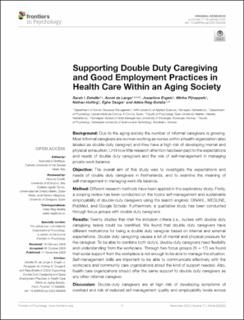| dc.contributor.author | Detaille, Sarah I. | |
| dc.contributor.author | de Lange, Annet | |
| dc.contributor.author | Engels, Josephine | |
| dc.contributor.author | Pijnappels, Mirthe | |
| dc.contributor.author | Hutting, Nathan | |
| dc.contributor.author | Osagie, Eghe | |
| dc.contributor.author | Reig-Botella, Adela | |
| dc.date.accessioned | 2021-02-02T13:26:12Z | |
| dc.date.available | 2021-02-02T13:26:12Z | |
| dc.date.created | 2020-12-06T16:52:21Z | |
| dc.date.issued | 2020 | |
| dc.identifier.citation | Frontiers in Psychology. 2020, 11 . | en_US |
| dc.identifier.issn | 1664-1078 | |
| dc.identifier.uri | https://hdl.handle.net/11250/2725842 | |
| dc.description.abstract | Background: Due to the aging society the number of informal caregivers is growing. Most informal caregivers are women working as nurses within a health organization (also labeled as double-duty caregiver) and they have a high risk of developing mental and physical exhaustion. Until now little research attention has been paid to the expectations and needs of double duty caregivers and the role of self-management in managing private-work balance.
Objective: The overall aim of this study was to investigate the expectations and needs of double duty caregivers in Netherlands, and to examine the meaning of self-management in managing work-life balance.
Method: Different research methods have been applied in this exploratory study. Firstly, a scoping review has been conducted on the topics self-management and sustainable employability of double-duty caregivers using the search engines: CINAHL, MEDLINE, PubMed, and Google Scholar. Furthermore, a qualitative study has been conducted through focus groups with double duty caregivers.
Results: Twenty studies that met the inclusion criteria (i.e., nurses with double duty caregiving tasks) could be identified. We found that double duty caregivers have different motivations for being a double duty caregiver based on internal and external expectations. Double duty caregiving causes a lot of mental and physical pressure for the caregiver. To be able to combine both duty’s, double duty caregivers need flexibility and understanding from the workplace. Through two focus groups (N = 17) we found that social support from the workplace is not enough to be able to manage the situation. Self-management skills are important to be able to communicate effectively with the workplace and community care organizations about the kind of support needed. Also, health care organizations should offer the same support to double duty caregivers as any other informal caregiver.
Discussion: Double-duty caregivers are at high risk of developing symptoms of overload and risk of reduced self-management quality and employability levels across time. Health care organizations and the double duty caregiver often wait too long to act instead of taking more preventive measures. Furthermore, community care organizations should dialog with double duty caregivers about their wishes concerning the division of caring tasks. This finding calls for special attention, with long-term solutions at both macro (health-care level), organizational (meso-level), and employee level (micro level). | en_US |
| dc.language.iso | eng | en_US |
| dc.publisher | Frontiers | en_US |
| dc.rights | Navngivelse 4.0 Internasjonal | * |
| dc.rights.uri | http://creativecommons.org/licenses/by/4.0/deed.no | * |
| dc.title | Supporting Double Duty Caregiving and Good Employment Practices in Health Care Within an Aging Society | en_US |
| dc.type | Peer reviewed | en_US |
| dc.type | Journal article | en_US |
| dc.description.version | publishedVersion | en_US |
| dc.source.pagenumber | 0 | en_US |
| dc.source.volume | 11 | en_US |
| dc.source.journal | Frontiers in Psychology | en_US |
| dc.identifier.doi | 10.3389/fpsyg.2020.535353 | |
| dc.identifier.cristin | 1856626 | |
| dc.description.localcode | Copyright © 2020 Detaille, de Lange, Engels, Pijnappels, Hutting, Osagie and Reig-Botella. This is an open-access article distributed under the terms of the Creative Commons Attribution License (CC BY). The use, distribution or reproduction in other forums is permitted, provided the original author(s) and the copyright owner(s) are credited and that the original publication in this journal is cited, in accordance with accepted academic practice. No use, distribution or reproduction is permitted which does not comply with these terms. | en_US |
| cristin.ispublished | true | |
| cristin.fulltext | original | |
| cristin.qualitycode | 2 | |

